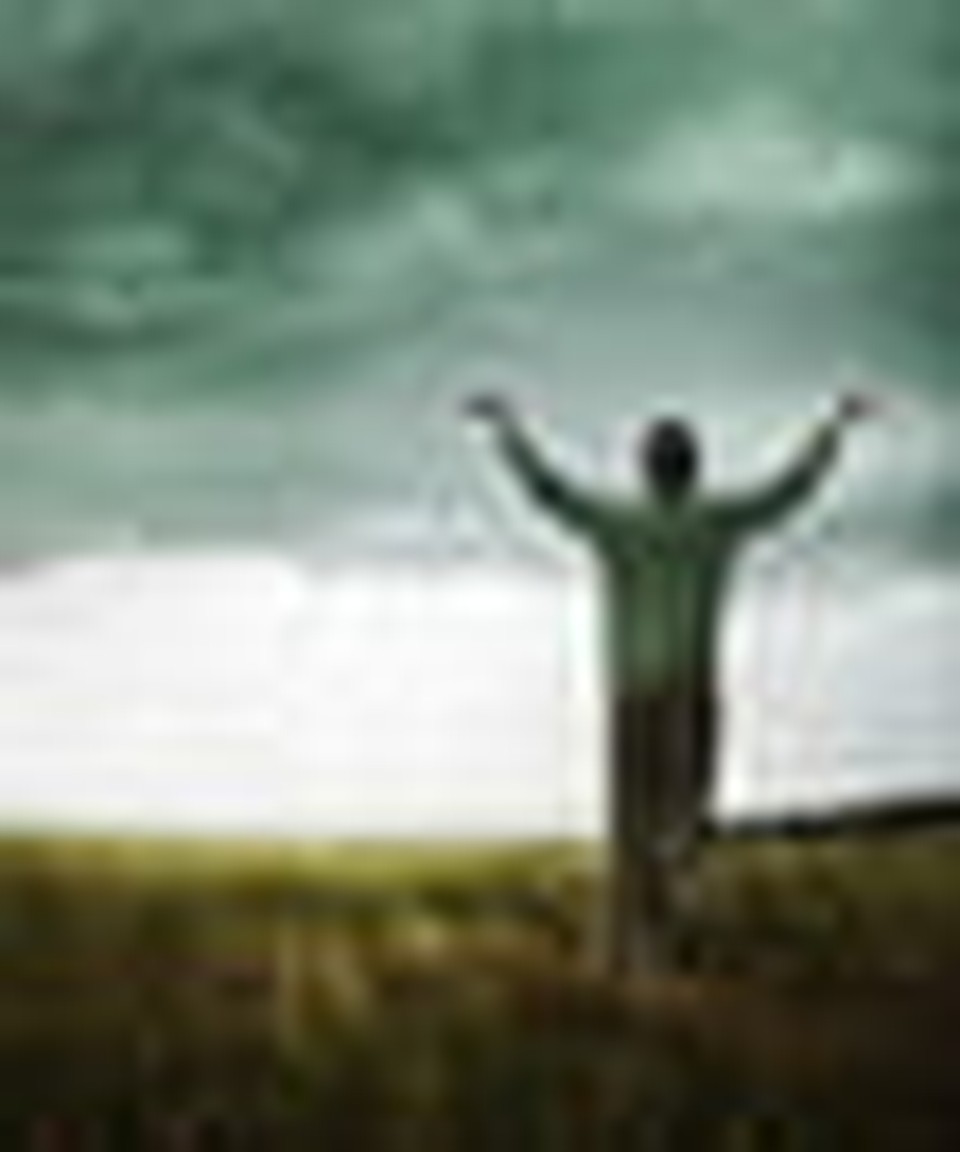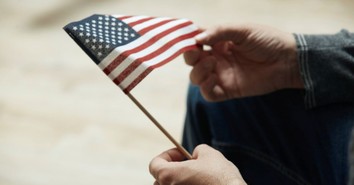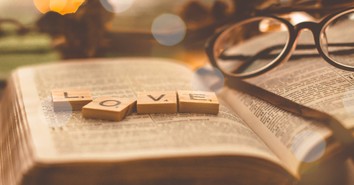The Glory of the Rainbow

Genesis 9:13-16: "I set My bow in the cloud, and it shall be for a token of a covenant between Me and the earth. And it shall come to pass, when I bring a cloud over the earth, that the bow shall be seen in the cloud: And I will remember My covenant, which is between Me and you and every living creature of all flesh; and the waters shall no more become a flood to destroy all flesh. And the bow shall be in the cloud; and I will look upon it, that I may remember the everlasting covenant between God and every living creature of all flesh that is upon the earth."
Genesis 9:8-17 deals with what theologians call the "Noahic Covenant." The covenant concept is a dominant Old Testament theme. The Hebrew always used for this concept is beriyth, a broad term covering several types of agreements, including a covenant between friends (1 Samuel 18:3) and rulers (1 Kings 5:12; "league").
While its etymology is uncertain, it might very well be related to the Akkadian burru, "to establish a legal situation by testimony with an oath." This is all the more possible because of the Septuagint's use of diathēkē to render beriyth, as the former also speaks of a legal transaction or testament. Similarly, the Latin pactum (English "pact") speaks of such a legal agreement or contract. In other words, all these words are stronger than just a general agreement, alliance or bond, especially when we are referring to the covenants of God.
The covenants of Scripture, therefore, are the permanent, legal transactions God made with various individuals that also extended to their descendants. Scripture reveals several covenants: Noahic (Gen. 9:9-17), Abrahamic (Genesis 12:1-3; Genesis 13:14-17; Genesis 17:1-22; and Genesis 22:16-18; cf. Galatians 3:8), Mosaic (Exodus 20:1-17; Exodus 21—Exodus 31), Davidic (2 Samuel 7:4-17) and New (Jeremiah 31:31-32; Hebrews 7:18-19, Hebrews 7:22; Hebrews 8:6-12).
The Noahic Covenant, then, which is spelled out here in Genesis 9:8-17, where it is also named the "Everlasting Covenant" (v. 16), is God's unconditional promise that He never will destroy the earth by flood again, regardless of how wicked people become and that He would continue to sustain the rhythms and balance of the earth for "perpetual generations" (v. 12). In other words, the Noahic Covenant will last forever and includes "every living creature of all flesh" (v. 15): humans, birds, beasts and wild animals. God gave this covenant to Noah and "perpetual generations" for our peace of mind. Man is able to enjoy life without worrying every time it starts to rain that the world might be destroyed again by flood.
It is also important to note God uses the phrase "every living creature" four times in this passage (vs. 10, 12, 15, 16). We probably would miss the significance of this if it were not for Revelation 4:6-7, where the apostle John sees a vision of the throne of God and four unusual "living creatures" before that throne worshipping God: "And before the throne there was a sea of glass like unto crystal: and in the midst of the throne, and round about the throne, were four beasts full of eyes before and behind. And the first beast was like a lion, and the second beast like a calf, and the third beast had a face as a man, and the fourth beast was like a flying eagle."
Here in these four categories is the entire range of animal life on the earth, including: wild beasts, cattle, humans and birds. This not only demonstrates that all living things bow before God's throne in worship, but also that God is concerned with His creation; it is ever on His sovereign mind.
To seal this covenant with creation, God gave a sign, something He also did when making other covenants. The sign and seal of the Abrahamic Covenant, for example, was circumcision (Genesis 17:11; Romans 4:9-12). Likewise, the weekly Sabbath was the sign of the Mosaic Covenant that God gave to racial Israel (Exodus 31:16-17).
So what was the sign God gave to all mankind and for all time that would remind them He never would destroy the earth again by a universal flood? The rainbow (vs. 13, 16). It is a perpetual, permanent and palpable reminder of God's wondrous grace and mercy. Let us take a few moments to consider the sign, the significance, and the solemnity of the rainbow.
I. The Sign of the Rainbow
The Hebrew word translated bow (or rainbow) is of tremendous significance, for it is the same word that refers to the familiar weapon. In fact, of the 77 occurrences of the Hebrew qeshet in the Old Testament, virtually all of them refer to the familiar weapon used by the hunter (Genesis 27:3) and the warrior (1 Samuel 31:3) that shoots arrows (2 Kings 9:24).
The bow is a truly ancient weapon, mentioned in Scripture for the first time in Genesis 21:20 (about 2000 BC) as being the weapon of choice of Ishmael, the son of Abraham and the Egyptian woman Hagar. Without doubt, however, it unquestionably existed before that. It was the common long distance weapon (300-400 yards) of the Egyptians, Syrians (1 Kings 22:34), Philistines (1 Samuel 31:3), Elamites (Isaiah 22:6), Lydians (Jeremiah 46:9), and ultimately the Hebrews (2 Samuel 1:18), of the which the Benjamites were experts (1 Chronicles 8:40). The Septuagint uses the equivalent Greek word toxon (Revelation 6:2).
Used figuratively, the bow symbolized victory (Psalms 7:12) as well as falsehood and deceit (Psalms 64:3-4; Hosea 7:16; Jeremiah 9:3). It also pictured disease or calamity sent by God (Job 6:4; Psalms 38:2), and it is that concept that leads us to the other use of qeshet.
In contrast to the weapon, the three appearances of qeshet in Genesis 9:13-16 refer to a very different bow, which we might call "God's bow." After first using His bow to bring the calamity of the flood in His battle with a wicked world, He then put away His bow, hanging it in the sky as a picture of peace. I was reminded here of old American westerns, where the hero would hang up his guns and be done with gun battles. God's bow hanging in the sky proclaimed to the world of that day and for all time that He never would destroy the earth again by a universal flood.
It's also important to notice God said the rainbow not only was reminder to us, but also a reminder to Him (v. 16): "I will look upon it, that I may remember the everlasting covenant." Obviously, this is an anthropomorphism, that is, putting something in human terms so we can grasp it. It's not that God has to remember, for He is omniscient, but rather that this is just a further assurance He will keep His promise.
The rainbow is a truly amazing and beautiful phenomenon, one that mesmerizes us every time it appears. It's probably safe to say few humans can see a rainbow and not stop what they are doing and gaze upon it. Rain did not occur before the flood, rather a mist watered the earth (Genesis 2:5-6). While there are some teachers who believe the rainbow already existed before this time and that God just gave it a new significance, we must disagree. That view, in fact, that the rainbow existed before the flood, actually comes from those who believe the flood was local, not universal. We would submit the mist that watered the earth clearly implies totally different atmospheric conditions, making it impossible for a rainbow to form. Additionally, the words, "I do set my bow in the cloud" (v. 13) seem to imply a new phenomenon that God initiates here for the first time.
It was the flood, therefore, that brought a drastic atmospheric change, allowing falling water droplets to form, each of which acts as a prism. When sunlight enters a raindrop, the light is first refracted (bent) as it enters the surface of the raindrop, is then reflected off the back of the drop, and is refracted once again as it leaves the drop. This splits the sunlight into the varied colors of the optical spectrum. When conditions are right—which is when the angle of reflection between the sun, the drop of water, and our line of sight is between 40 and 42 degrees—we see this spectrum. It is most commonly listed in Isaac Newton's sevenfold order: red (inside), orange, yellow, green, blue, indigo and violet (outside). Newton was the first person to demonstrate that white light is composed of the light of all the colors of the rainbow. Newton's color list is also commonly remembered by the popular mnemonics "Roy G. Biv" and "Richard Of York Gave Battle In Vain."
As if this were not beautiful enough, at times a secondary rainbow is formed outside the primary arc. This occurs when some light is reflected twice inside the raindrop before exiting. This causes the secondary rainbow to be fainter but still distinguishable when the observer is at 50 to 53 degrees. Amazingly, because of this mirroring effect inside the raindrop, the colors of this rainbow are in reverse order, with violet on the outside and red on the inside.
II. The Significance of the Rainbow
The rainbow appears three more times in Scripture, once in the Old Testament and twice in the New. When we compare all these occurrences, we see a three-fold significance that applies to the storms of life that the believer will encounter.
First, Noah saw the rainbow after the storm. While a storm rages, it is difficult to think about anything else. Our foremost thoughts are simply finding shelter and hoping it doesn't do serious damage. Like Noah, we must wait until it's all over before seeing the sun again. It is then that we are reassured by the rainbow that every storm is temporary and that no matter how much damage it does, it can always be worse.
Second, the prophet Ezekiel saw the rainbow during the storm. Ezekiel 1—3 records the prophet's call, first describing the visions he saw (Ezekiel 1) and then the voice he heard (Ezekiel 2 Ezekiel 3). No Scripture writer ever tried to describe God directly but did so only using images that the human mind could grasp.
Ezekiel's visions of God began with a violent storm of horrendous wind and fiery lightning, demonstrating God's judgment power and blazing glory (v. 4). Then came four "living creatures" (vv. 5-14), undoubtedly cherubs (Ezekiel 9:3; Ezekiel 10:5-20), which are always symbolic of God's holy presence and unapproachability, as in their guarding God's glory in the Holy of Holies (Exodus 25:10-22; Psalms 80:1). Next, beside each cherub was a wheel within a wheel (vv. 15-21), which seems to picture a chariot-throne that is in motion and moving toward judgment upon Jerusalem.
Finally, Ezekiel's fourth vision (vv. 22-28) included a "firmament" (an expanse) over the heads of the cherubs that dazzled like crystal, "the likeness of a throne," and the "likeness...of a man" on that throne, undoubtedly the pre-incarnate Son of God. It was then that a rainbow appeared, "the brightness" of which shown not in the semi-circle of a normal rainbow, rather "round about" (sābîb, surrounding, all around), a complete eternal circle all around to "the likeness of the glory of the LORD" (v. 28).
Indeed, Ezekiel saw the rainbow during the storm, one unlike any other, to which his response was to "fell upon [his] face" in humble submission. Let us be reminded during the storms that come that God is on the throne and we are to submit to all that He is doing.
Third, not only do we the rainbow in Scripture after the storm (Noah) and during the storm (Ezekiel), but we also see it before the storm, as revealed in the New Testament.
Similar to Ezekiel, the apostle John had a vision of the throne of God in heaven and wrote, "And he that sat [on the throne] was to look upon like a jasper and a sardine stone: and there was a rainbow round about the throne, in sight like unto an emerald" (Revelation 4:3). The Greek for rainbow is iris, which appears only here and in Revelation 10:1 and was used from the time of Homer for rainbow. In classical Greek, it refers to any bright halo surrounding an object, including the iris of the eye and the circle around the eyes of the peacock's feathers. This is, of course, the origin of our English word iris because of the numerous colors found among this family's 200-300 species of flowers.
Again similar to Ezekiel, John saw a rainbow encircling God's throne, announcing the completeness and perfection of God. This multi-colored bow is dominated by a soothing emerald green. As a symbol, then, of peace and God's faithfulness to His promises, this bow assures John before the coming horrendous judgments even start that there will be peace when it is all done.
It continues to amaze this writer that some Bible students can read Revelation and deny its future significance, casually dismissing it as a description of the events of 70 AD, when the Roman general Titus sacked Jerusalem. Our Lord Himself said of the coming Tribulation period described in such graphic detail in chapters 4—19, "For then shall be great tribulation, such as was not since the beginning of the world to this time, no, nor ever shall be" (Matthew 24:21). Nothing in history comes even remotely close to the incomprehensible events that are to come upon this rebellious world. That is precisely why God reassures John that no matter what happens, peace will come, God's people will be delivered, and God will be glorified (a further reminder comes later in 10:1).
Dear Christian Friend, all this reminds us that God is always faithful to His promises. Whether we see the rainbow before, during or after the storm of trial, we are always assured of "the peace of God, which passeth all understanding, [which] shall keep [our] hearts and minds through Christ Jesus" (Philippians 4:7).
III. The Solemnity of the Rainbow
It is difficult, indeed, perhaps even impossible, for us today to fully fathom the solemnity of that moment when the first rainbow appeared. After what Noah and his family had been through, their first response upon exiting the ark was worship (Genesis 8:20), praising God for their deliverance from the incomprehensible destruction that had just occurred. It is then on the heels of that worship that God gave His promise and hung His assuring sign of that promise in the sky. Such solemnity provides us with at least three closing principles.
The Rainbow Is a Remembrance of God's Power
Every time we look at a rainbow, we remember the flood. It is virtually automatic. What is it that we remember or at least should remember? We should remember that in His sovereign, omnipotent power God destroyed the earth because of sin. Because of His holy nature, God cannot tolerate sin. In a day when God is viewed as a tolerant grandfather who simply smiles understandingly at sin, men need to be told God is a God of retribution and wrath who will bring judgment on those who reject Him. As in those very days of Noah, God "shall not always strive with man" (Genesis 6:3).
We also remember, however, not only God's power to execute wrath, but also His power to save. As He saved Noah and him family because they believed and obeyed what He said, He saves those today who receive Him as Savior and Lord.
This prompts us also to remember constantly God's wondrous grace. "Noah found grace in the eyes of the LORD" (Genesis 6:8). We find the phrase "found grace," in fact, 18 times in the Old Testament. Lot "found grace" in God (Genesis 19:19), and Moses "found grace" in God (Exodus 33:12-13). Even in wrath there is mercy and grace, and how we should rejoice in it!
The Rainbow Is a Reminder of God's Purpose
The appearance of the rainbow to Noah, Ezekiel, and the apostle John are all powerful reminders that God always has a purpose, even in the storms. As He revealed to the Apostle Paul, "We know that all things work together for good to them that love God, to them who are the called according to his purpose" (Romans 8:28). Paul goes on in the next two verses to outline what theologians have called "God's Golden Chain of Salvation": "For whom he did foreknow, he also did predestinate to be conformed to the image of his Son, that he might be the firstborn among many brethren. Moreover whom he did predestinate, them he also called: and whom he called, them he also justified: and whom he justified, them he also glorified."
Just as our salvation is by God's sovereign purpose, all the storms that come our way are also by His sovereign purpose. Yes, storms will come. As Paul assured Timothy, "Yea, and all that will live godly in Christ Jesus shall suffer persecution" (2 Timothy 3:12), but there is a reason for it all. Peter reassures us: "That the trial of your faith, being much more precious than of gold that perisheth, though it be tried with fire, might be found unto praise and honour and glory at the appearing of Jesus Christ: Whom having not seen, ye love; in whom, though now ye see him not, yet believing, ye rejoice with joy unspeakable and full of glory" (1 Peter 1:7-8).
Likewise, Paul adds: "For I reckon that the sufferings of this present time are not worthy to be compared with the glory which shall be revealed in us" (Romans 8:18). That leads us to one other comforting principle.
The Rainbow Is a Reassurance of God's Peace
As mentioned earlier, the rainbow assured Noah, and it now reassures us, that God is always faithful to His promises. Whether we see the rainbow before, during, or after the storm of trial, we are always assured of "the peace of God, which passeth all understanding, [which] shall keep [our] hearts and minds through Christ Jesus" (Philippians 4:7). As Isaiah the prophet put it: "Thou wilt keep him in perfect peace, whose mind is stayed on thee: because he trusteth in thee" (Isaiah 26:3). Most important of all, our Lord assures us: "Peace I leave with you, my peace I give unto you: not as the world giveth, give I unto you. Let not your heart be troubled, neither let it be afraid" (John 14:27).
So, dear Christian Friend, the next time you look at a rainbow, may you remember, be reminded and be reassured of who God is and what He is doing.
Dr. J.D. Watson, Th.D., DRE, entered the ministry in 1974, serving in several capacities including 29 years in the pastorate, 26 of which at Grace Bible Church in Meeker, Colorado. He also speaks at Bible conferences and other venues. In addition to his published books, he continues to write and edit the monthly publication Truth on Tough Texts.
Originally published May 27, 2014.







